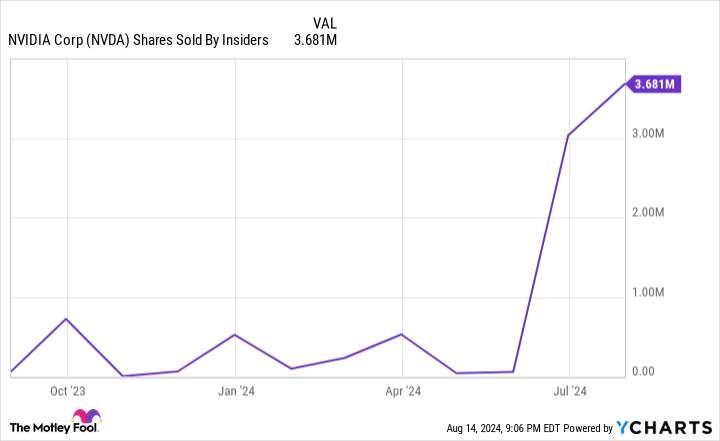The most important data release of the quarter occurred earlier this week — and I’m not talking about the much-anticipated July inflation report.
No later than 45 calendar days following the end to a quarter, institutional investors with at least $100 million in assets under management are required to file Form 13F with the Securities and Exchange Commission. A 13F offers an under-the-hood glimpse of which stocks Wall Street’s smartest, most-successful, and richest investors have been buying and selling.
Despite the limitations of 13Fs — e.g., they can be 45 days old when filed, meaning the data you’re seeing might be stale for active fund managers — they provide invaluable clues as to what stocks, industries, sectors, and trends are piquing the interest of Wall Street’s brightest asset managers.

While there’s been plenty of buying and selling activity for companies involved in what’s currently the buzziest investment opportunity, artificial intelligence (AI), the theme for the latest round of 13Fs is that Wall Street’s billionaire investors are continuing to pare down their stakes in AI darling Nvidia (NASDAQ: NVDA).
Nvidia has become the hardware backbone of the artificial intelligence movement
Since the page was turned to 2023, shares of Nvidia have catapulted higher by 709%, as of the closing bell on Aug. 14, which translates into an increase in market cap of more than $2.5 trillion. Quite a few billionaire investors and their funds have benefited immensely from this move higher.
The catalyst behind this historic gain for a market-leading business is the company’s data-center hardware. More specifically, Nvidia’s H100 graphics processing unit (GPU) has become the brains powering the split-second decision-making needed in enterprise data centers running generative AI solutions and training large language models. In 2023, Nvidia’s chips had a near-monopoly (98% share) of the GPUs shipped to data centers, per TechInsights.
The beauty of having an in-demand product is the exceptional pricing power that usually comes with it. With demand for the H100 outstripping supply, Nvidia has been able to increase the selling price of its AI-GPU to between $30,000 and $40,000. The end result being a big uptick in the company’s adjusted gross margin.
But not all money managers believe Wall Street’s AI leader has enough gas left in the proverbial tank to deliver for investors.
Billionaire money managers sold shares of Nvidia for a third consecutive quarter
According to newly filed 13Fs on Aug. 14, seven prominent billionaire asset managers were sellers of Nvidia’s stock during the June-ended quarter (total shares sold in parenthesis):
-
Ken Griffin of Citadel Advisors (9,282,018 shares)
-
David Tepper of Appaloosa (3,730,000 shares)
-
Stanley Druckenmiller of Duquesne Family Office (1,545,370 shares)
-
Cliff Asness of AQR Capital Management (1,360,215 shares)
-
Israel Englander of Millennium Management (676,242 shares)
-
Steven Cohen of Point72 Asset Management (409,042 shares)
-
Philippe Laffont of Coatue Management (96,963 shares)
During the March quarter, eight billionaire investors — nine, if you include Jim Simons of Renaissance Technologies, who passed away in May — sent shares of Nvidia to the chopping block, while eight select billionaires were also sellers in the December-ended quarter.
Although profit-taking following a monstrous run higher is a logical explanation behind this billionaire investor exodus, there are close to a half-dozen other factors that may shed more light on why money managers keep heading for the exit.

Five reasons billionaires can’t stop selling shares of Nvidia
History might just be the clearest reason billionaires are steadily heading to the sideline. Every next-big-thing technology and trend over the last 30 years has navigated its way through an early stage bubble.
Put another way, investor expectations with regard to adoption and utility have far exceeded reality for every buzzy innovation or trend over the last three decades. With most businesses lacking a well-defined blueprint as to how they’ll generate a positive return on their AI investments, it’s looking likely that AI is the next in a long line of next-big-thing bubbles. If the AI bubble bursts, no stock would, arguably, be hit harder than Nvidia.
The expectation for a meaningful increase in competition is another reason billionaires may be showing shares of Nvidia to the door. Given AI’s massive addressable market, a number of external competitors are entering the picture with AI-GPUs of their own.
Furthermore, Nvidia’s four largest customers by net sales are internally developing AI chips for their data centers. These complementary chips will minimize the “real estate” in high-compute data centers for Nvidia’s hardware.
Thirdly, billionaires are wisely not overlooking the ceiling that regulators have put in place. In 2022, and again in 2023, U.S. regulators imposed export restrictions to China for Nvidia’s high-powered AI chips. Following the first round of restrictions in 2022, Nvidia developed the toned-down H800 and A800 chips for the world’s No. 2 economy. Unfortunately, these GPUs were added to the export restriction list last year. These restrictions may cost Nvidia billions of dollars in quarterly sales.
A fourth catalyst behind this ongoing selling by billionaires might have to do with the lack of buying we’ve witnessed from company insiders. There hasn’t been an open-market purchase of Nvidia stock from an executive or board member since December 2020. Meanwhile, CEO Jensen Huang has been selling his company’s stock hand over fist since mid-June.
While not all insider selling is bad news — some sales may be done for tax purposes — a complete lack of buying activity suggests none of Nvidia’s higher-ups believe shares are a good value.
Lastly, Nvidia’s valuation is an eyesore. Although its forward price-to-earnings (P/E) ratio suggests shares might actually be inexpensive, its trailing-12-month (TTM) price-to-sales (P/S) ratio reached levels in June thar rivaled the TTM P/S peaks observed from the likes of Cisco Systems and Amazon prior to the dot-com bubble bursting.
In spite of the euphoria surrounding artificial intelligence, the actions of some of Wall Street’s brightest investment minds appear to suggest that trouble lies ahead.
Should you invest $1,000 in Nvidia right now?
Before you buy stock in Nvidia, consider this:
The Motley Fool Stock Advisor analyst team just identified what they believe are the 10 best stocks for investors to buy now… and Nvidia wasn’t one of them. The 10 stocks that made the cut could produce monster returns in the coming years.
Consider when Nvidia made this list on April 15, 2005… if you invested $1,000 at the time of our recommendation, you’d have $723,545!*
Stock Advisor provides investors with an easy-to-follow blueprint for success, including guidance on building a portfolio, regular updates from analysts, and two new stock picks each month. The Stock Advisor service has more than quadrupled the return of S&P 500 since 2002*.
*Stock Advisor returns as of August 12, 2024
John Mackey, former CEO of Whole Foods Market, an Amazon subsidiary, is a member of The Motley Fool’s board of directors. Sean Williams has positions in Amazon. The Motley Fool has positions in and recommends Amazon, Cisco Systems, and Nvidia. The Motley Fool has a disclosure policy.
Billionaires Are Dumping Shares of Artificial Intelligence (AI) Stock Nvidia for a Third Straight Quarter — Here’s Why was originally published by The Motley Fool
EMEA Tribune is not involved in this news article, it is taken from our partners and or from the News Agencies. Copyright and Credit go to the News Agencies, email news@emeatribune.com Follow our WhatsApp verified Channel






